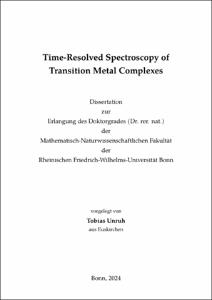Time-Resolved Spectroscopy of Transition Metal Complexes

Time-Resolved Spectroscopy of Transition Metal Complexes

| dc.contributor.advisor | Vöhringer, Peter | |
| dc.contributor.author | Unruh, Tobias | |
| dc.date.accessioned | 2024-01-23T11:09:53Z | |
| dc.date.available | 2024-01-23T11:09:53Z | |
| dc.date.issued | 23.01.2024 | |
| dc.identifier.uri | https://hdl.handle.net/20.500.11811/11260 | |
| dc.description.abstract | Owing to their thermodynamic properties, transition metal azido compounds are often prone to decomposition. Frequently, this occurs under release of dinitrogen giving rise to nitrene or nitride complexes which are of fundamental interest due to their peculiar reactive properties. In this thesis, time-resolved pump probe spectroscopy was applied to explore the ultrafast photochemical and photophysical processes of two representatives of this class of compounds.
First, the octahedral electon-rich d6 low-spin complex trans-bis(acetylacetonato)azidopyridinecobalt(III) (trans – Co(acac)2(N3))(py))was investigated. Aswas deduced from clear dynamic changes in the infrared spectrum of the compound under ambient conditions in solution, the complex is subject to a trans-cis equilibration. The kinetics of this process were investigated in more detail by Fourier transform infrared spectroscopy. A pronounced temperature dependence of the reaction was found and an increase of the rate constant by more than two orders of magnitudes was observed. From the temperature dependency of this reaction, the activation barrier was estimated as 122 kJ mol-1. The experimental findings were backed up by computational studies which gave convincing evidence, that the reaction mechanism involves temporary pyridine dissociation and occurs via an inverse Berry pseudorotation pathway. Leveraging the structure sensitivity of UV-pump mid-infrared-probe spectroscopy, the states involved in the ultrafast photophysical mechanismwere probed. Aswas shown, upon excitation at 266nman ultrashort lived acac ligand-to-metal charge transfer (LMCT) state is prepared, that essentially decays within the time resolution of the experiment in favor of the 1LMCTazide state. This configuration, which is characterized by its photooxidized azidyl radical ligand, relaxes to a singlet metal centered state within a few picoseconds which ultimately repopulates the ground state. Opposed to many other azido system, no appreciable photoreactivity of the system, but instead quantitative ground state recovery within no more than 30 ps was observed, suggesting that this peculiar consecutive pathway and the remarkably short lifetime of the 1LMCTazide state renders the complex particularly robust against photodegradation. Next, studies were extended to the late electron-rich square planar d8 complex diazido[1,2-bis(diphenylphosphino)ethane]nickel(ii) (Nidppe(N3)2), which according to reports in the literature is prone to formation of a fleeting reactive transition metal nitrene species. To explore the underlying photophysical and photochemical processes that enable this reactivity, this system was likewise studied by UV-pump mid-infrared-probe spectroscopy. Based on these spectroscopic measurements, it was established that upon excitation at 266nm, the system is first prepared in its 1LMCTdppe state. The molecule then dissipates its excess energy to the surrounding or onto energetically lower lying vibrational modes within less than 4 ps. A subsequent intersystem crossing step then populates the triplet ground state of the parent molecule. The system is trapped on the triplet surface for several thousands picoseconds. From here it ultimately undergoes intersystem recrossing or with a time constant of roughly 4.3 ns the complex cleaves off dinitrogen to furnish the sought-after nickel nitrene compound that enables the photoreactivity of the system that was reported before. | en |
| dc.language.iso | eng | |
| dc.rights | Namensnennung 4.0 International | |
| dc.rights.uri | http://creativecommons.org/licenses/by/4.0/ | |
| dc.subject | Pump-Probe-Spektroskopie | |
| dc.subject | Laserspektroskopie | |
| dc.subject | Zeitaufgelöste Spektroskopie | |
| dc.subject | Azido-Komplexe | |
| dc.subject | Photochemie | |
| dc.subject | Cobalt | |
| dc.subject | Nickel | |
| dc.subject | Pump-Probe Spectroscopy | |
| dc.subject | Laser Spectroscopy | |
| dc.subject | Time-Resolved Spectroscopy | |
| dc.subject | Azido Complexes | |
| dc.subject | Photochemistry | |
| dc.subject.ddc | 540 Chemie | |
| dc.title | Time-Resolved Spectroscopy of Transition Metal Complexes | |
| dc.type | Dissertation oder Habilitation | |
| dc.identifier.doi | https://doi.org/10.48565/bonndoc-206 | |
| dc.publisher.name | Universitäts- und Landesbibliothek Bonn | |
| dc.publisher.location | Bonn | |
| dc.rights.accessRights | openAccess | |
| dc.identifier.urn | https://nbn-resolving.org/urn:nbn:de:hbz:5-73910 | |
| ulbbn.pubtype | Erstveröffentlichung | |
| ulbbnediss.affiliation.name | Rheinische Friedrich-Wilhelms-Universität Bonn | |
| ulbbnediss.affiliation.location | Bonn | |
| ulbbnediss.thesis.level | Dissertation | |
| ulbbnediss.dissID | 7391 | |
| ulbbnediss.date.accepted | 08.01.2024 | |
| ulbbnediss.institute | Mathematisch-Naturwissenschaftliche Fakultät : Fachgruppe Chemie / Institut für Physikalische und Theoretische Chemie | |
| ulbbnediss.fakultaet | Mathematisch-Naturwissenschaftliche Fakultät | |
| dc.contributor.coReferee | Filippou, Alexander C. | |
| ulbbnediss.contributor.gnd | 1382739354 |
Files in this item
This item appears in the following Collection(s)
-
E-Dissertationen (4461)




